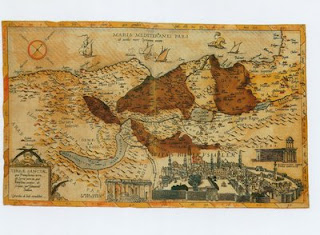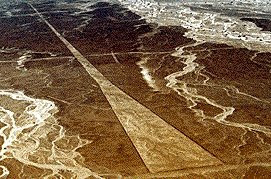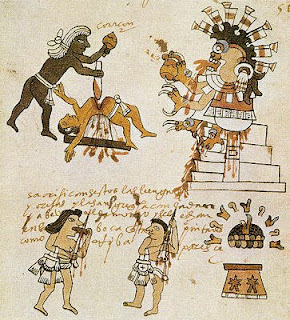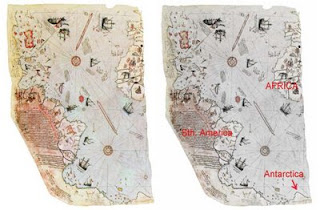
Marduk, the king of gods defeating Tiamat, the Goddess of Chaos
Truly, one of the most difficult tasks in attempting to understand what many of the ancient texts are actually trying to say to us is breaking through the layers of metaphor and myth. People have sometimes commented to me that it would be nice if some of these stories just came right out and said what they mean, but it must be understood that some of these tales are extremely ancient and when you consider the options, the reasons for preserving the information as colorful myths are really very simple and quite clever too, I might add.
In reality, it’s much easier to preserve a nice story than it is to preserve technical information as people always prefer to listen to a nice story. Let’s imagine for example, that we wished to preserve the event of the Comet, Levy-Shoemaker-nine, impacting with Jupiter. Rather than give dates and names for things that we’re not even sure will be understood thousands of years from now we could associate the event with a grandly tale involving people and preserve it as a myth. Let’s for arguments sake, pretend that Mars and Venus were in alignment when the event occurred. We could create a simple tale of three Gods:
“There was once, a mighty warrior God who one day, while making a long voyage, met a beautiful maiden in a gown of blue at the edge of a great expanse of ocean. The maiden was his sister, a Goddess and the two tarried together a while conversing, for they had not seen each other in many years. But meanwhile, as they spoke together, their mighty brother God, a Giant with a single great red eye who adorned himself in robes of many colors, was attacked by an outside invader. At first, seeking to catch the giant off guard, the invader appeared as only one solitary attacker but soon cast off its disguise and divided, to reveal a force of 9 strong. It then became clear to the Giant that the attackers were his subjects, mainly cobblers who were angry at the unfair levy the God has imposed upon their trade and seeking retribution. However the force was no match for the solitary giant who, though wounded in the battle, fought back bravely and withstood the blows which numbered 20, finally devouring his foes and absorbing their essences into his Godly self.”
OK, so now all we need to do is leave behind enough information for people in the future to be able to associate the warrior with Mars and his sister in blue with Venus and The Giant in many colors with the great red eye, with Jupiter. We have comfortably dated the event by incorporated the alignment between Mars and Venus by our brother and sisters ‘meeting’ and dalliance at a far off place when Jupiter was attacked. We have even been able to make a reference to Levy- Shoemaker Nine, and the fact that it broke into 20 pieces with our inference to a force of nine ‘cobblers’ angry at a new ‘levy’ delivering 20 blows. We have covered the fact that some severe and visible wounds were left on Jupiter from the impacts and also shown that the fragments were ultimately absorbed into the mass of the planet.
So there we have a nice little ‘Myth,’ to explain the event of comet levy-shoemaker nine impacting with Jupiter, though please understand that there was no actual alignment between Venus and mars during the comet impact I’m referring to. It was a fictitious event merely used to demonstrate a point. But as you can easily see from this example, an event described in metaphor and presented as a story, is much more likely to be actually told and accurately handed down in oral traditions or written down to be read by people than technical data because names and dates are forgotten, event continuity becomes muddled, and quite frankly, technical data simply confuses too many people whereas campfire tales do not.
It’s easy to see how and why many actual events have been recorded and preserved in the form of myths. There is no reason to believe that people, thousands of years into the future, will ever be able to translate your language in entirety, look at all the nuances and double meanings in English for example. It’s much easier to preserve an event in myth and then leave behinds the means to associate the characters with their celestial and terrestrial counterparts. This has been clearly demonstrated in the Babylonian description of the cosmic collision described in Sumerian texts, as Marduk, the king of gods defeating Tiamat, the Goddess of Chaos, in a great cosmic battle, splitting her in two and forming heaven and earth from her two halves. Interestingly, in this case, ‘chaos’ could very easily be interpreted as being similar to the biblical terminology of "void and without form" that is used in genesis. Chaos also figures prominently in Greek mythology as being the stuff from which the earth was formed before the creation of the gods. The Babylonian version also contains obvious and substantial elements of the earlier Sumerian account.
The real beauty of using myth as a means of transmitting complicated information is that you can rely on uneducated people to transmit the information with a certain degree of accuracy. Then, as long as those who live in the future have the means to decipher the code you have used correctly, the knowledge is secure.
The only two coded languages you need to use are astronomy and mathematics and in all reality, these are the only two languages available to you because they are the only two languages that are guaranteed to remain consistent over exceptionally lengthy periods of time.
 Reconstruction of the Antikythera mechanism in the National Archaeological Museum, Athens (made by Robert J. Deroski, based onDerek J. de Solla Price model).
Reconstruction of the Antikythera mechanism in the National Archaeological Museum, Athens (made by Robert J. Deroski, based onDerek J. de Solla Price model).
































